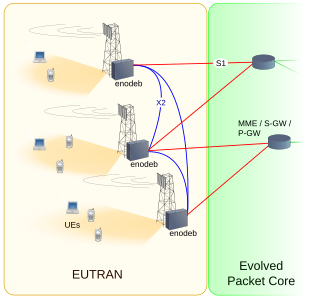
Enhanced Data rates for GSM Evolution (EDGE), also known as 2.75G, Enhanced GPRS (EGPRS), IMT Single Carrier (IMT-SC), and Enhanced Data rates for Global Evolution, is a 2G digital mobile phone technology for data transmission. It is a subset of General Packet Radio Service (GPRS) on the GSM network and improves upon it offering speeds close to 3G technology, hence the name 2.75G. It is also recognized as part of the International Mobile Telecommunications - 2000 (IMT-2000) standard.

Worldwide Interoperability for Microwave Access (WiMAX) is a family of wireless broadband communication standards based on the IEEE 802.16 set of standards, which provide physical layer (PHY) and media access control (MAC) options.

4G is the fourth generation of cellular network technology, succeeding 3G and designed to support all-IP communications and broadband services, enabling a variety of data-intensive applications. A 4G system must meet the performance requirements defined by the International Telecommunication Union (ITU) in IMT Advanced. 4G supports a range of applications, including enhanced mobile internet access, high-definition streaming, IP telephony, video conferencing, and the expansion of Internet of Things (IoT) applications.

Evolution-Data Optimized is a telecommunications standard for the wireless transmission of data through radio signals, typically for broadband Internet access. EV-DO is an evolution of the CDMA2000 (IS-2000) standard which supports high data rates and can be deployed alongside a wireless carrier's voice services. It uses advanced multiplexing techniques including code-division multiple access (CDMA) as well as time-division multiplexing (TDM) to maximize throughput. It is a part of the CDMA2000 family of standards and has been adopted by many mobile phone service providers around the world particularly those previously employing CDMA networks. It is also used on the Globalstar satellite phone network.
The IP Multimedia Subsystem or IP Multimedia Core Network Subsystem (IMS) is a standardised architectural framework for delivering IP multimedia services. Historically, mobile phones have provided voice call services over a circuit-switched-style network, rather than strictly over an IP packet-switched network. Various voice over IP technologies are available on smartphones; IMS provides a standard protocol across vendors.

Orthogonal frequency-division multiple access (OFDMA) is a multi-user version of the popular orthogonal frequency-division multiplexing (OFDM) digital modulation scheme. Multiple access is achieved in OFDMA by assigning subsets of subcarriers to individual users. This allows simultaneous low-data-rate transmission from several users.

E-UTRA is the air interface of 3rd Generation Partnership Project (3GPP) Long Term Evolution (LTE) upgrade path for mobile networks. It is an acronym for Evolved UMTS Terrestrial Radio Access, also known as the Evolved Universal Terrestrial Radio Access in early drafts of the 3GPP LTE specification. E-UTRAN is the combination of E-UTRA, user equipment (UE), and a Node B.

Wi-Fi calling, also called VoWiFi, refers to mobile phone voice calls and data that are made over IP networks using Wi-Fi, instead of the cell towers provided by cellular networks. Using this feature, compatible handsets are able to route regular cellular calls through a wireless LAN (Wi-Fi) network with broadband Internet, while seamlessly changing connections between the two where necessary. This feature makes use of the Generic Access Network (GAN) protocol, also known as Unlicensed Mobile Access (UMA).
In a hierarchical telecommunications network, the backhaul portion of the network comprises the intermediate links between the core network, or backbone network, and the small subnetworks at the edge of the network.

High Speed Packet Access (HSPA) is an amalgamation of two mobile protocols—High Speed Downlink Packet Access (HSDPA) and High Speed Uplink Packet Access (HSUPA)—that extends and improves the performance of existing 3G mobile telecommunication networks using the WCDMA protocols. A further-improved 3GPP standard called Evolved High Speed Packet Access was released late in 2008, with subsequent worldwide adoption beginning in 2010. The newer standard allows bit rates to reach as high as 337 Mbit/s in the downlink and 34 Mbit/s in the uplink; however, these speeds are rarely achieved in practice.
Media Independent Handover (MIH) is a standard being developed by IEEE 802.21 to enable the handover of IP sessions from one layer 2 access technology to another, to achieve mobility of end user devices (MIH).

Evolved High Speed Packet Access, HSPA+, HSPA (Plus) or HSPAP, is a technical standard for wireless broadband telecommunication. It is the second phase of HSPA which has been introduced in 3GPP release 7 and being further improved in later 3GPP releases. HSPA+ can achieve data rates of up to 42.2 Mbit/s. It introduces antenna array technologies such as beamforming and multiple-input multiple-output communications (MIMO). Beamforming focuses the transmitted power of an antenna in a beam toward the user's direction. MIMO uses multiple antennas on the sending and receiving side. Further releases of the standard have introduced dual carrier operation, i.e. the simultaneous use of two 5 MHz carriers. HSPA+ is an evolution of HSPA that upgrades the existing 3G network and provides a method for telecom operators to migrate towards 4G speeds that are more comparable to the initially available speeds of newer LTE networks without deploying a new radio interface. HSPA+ should not be confused with LTE though, which uses an air interface based on orthogonal frequency-division modulation and multiple access.
The 3GPP has defined the Voice Call Continuity (VCC) specifications in order to describe how a voice call can be persisted, as a mobile phone moves between circuit switched and packet switched radio domains.

In telecommunications, long-term evolution (LTE) is a standard for wireless broadband communication for mobile devices and data terminals based on the GSM/EDGE and UMTS/HSPA standards. It improves on those standards' capacity and speed by using a different radio interface and core network improvements. LTE is the upgrade path for carriers with both GSM/UMTS networks and CDMA2000 networks. Because LTE frequencies and bands differ from country to country, only multi-band phones can use LTE in all countries where it is supported.

International Mobile Telecommunications-Advanced are the requirements issued by the ITU Radiocommunication Sector (ITU-R) of the International Telecommunication Union (ITU) in 2008 for what is marketed as 4G mobile phone and Internet access service.
Access network discovery and selection function (ANDSF) is an entity within an evolved packet core (EPC) of the system architecture evolution (SAE) for 3GPP compliant mobile networks. The purpose of the ANDSF is to assist user equipment (UE) to discover non-3GPP access networks – such as Wi-Fi or WIMAX – that can be used for data communications in addition to 3GPP access networks and to provide the UE with rules policing the connection to these networks.
LTE-WLAN aggregation (LWA) is a technology defined by the 3GPP. In LWA, a mobile handset supporting both LTE and Wi-Fi may be configured by the network to utilize both links simultaneously. It provides an alternative method of using LTE in unlicensed spectrum, which unlike LAA/LTE-U can be deployed without hardware changes to the network infrastructure equipment and mobile devices, while providing similar performance to that of LAA. Unlike other methods of using LTE and WLAN simultaneously, LWA allows using both links for a single traffic flow and is generally more efficient, due to coordination at lower protocol stack layers.
5G NR is a radio access technology (RAT) developed by the 3rd Generation Partnership Project (3GPP) for the 5G mobile network. It was designed to be the global standard for the air interface of 5G networks. It is based on orthogonal frequency-division multiplexing (OFDM), as is the 4G long-term evolution (LTE) standard.
5G network slicing is a network architecture that enables the multiplexing of virtualized and independent logical networks on the same physical network infrastructure. Each network slice is an isolated end-to-end network tailored to fulfill diverse requirements requested by a particular application.







